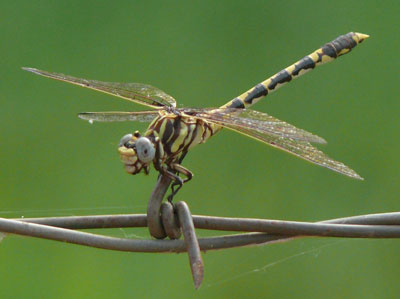|
back Home Life Along a
|
|
Common Sanddragon
Progomphus obscurus|
© Victor W. Fazio III, aves.net |
This dragonfly is in the family of clubtail dragonflies, so called because of the end of its abdomen is enlarged and appears club-like. However, some refer to these dragonflies as burrowing dragonflies because the larvae, which live underwater, burrow into the substrate. The common sanddragon has widely spaced eyes, are 4-7 cm long, and, like all dragonflies, hold their paired wings flat out and to the sides of its body. The adult common sanddragon can be seen perching along the edges of sandy-bottomed rivers across Oklahoma and much of the eastern U.S. Both the larvae and adults are carnivorous predators. Generally the larvae eat aquatic insects, but large dragonflies have been known to eat small fish and tadpoles. The adults like to eat mosquitoes, gnats, mayflies, and other small flying insects. The dragonfly uses its legs, which form a basket, to catch insects while flying. Females lay eggs into the water by quickly flying low over the water’s surface and tapping their abdomens on the water. This is one of the few dragonflies where the male mate guards the female while she lay eggs. |
|
back to species list |
PDF of all species profiles
|

